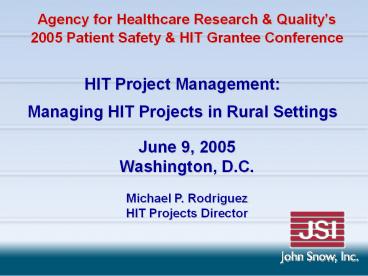HIT Project Management: Managing HIT Projects in Rural Settings - PowerPoint PPT Presentation
Title:
HIT Project Management: Managing HIT Projects in Rural Settings
Description:
Title: AHRQ HIT Meeting -- Managing Rural HIT Projects Author: Michael P. Rodriguez Last modified by: User Created Date: 4/12/2002 3:40:34 PM Document presentation format – PowerPoint PPT presentation
Number of Views:444
Avg rating:3.0/5.0
Title: HIT Project Management: Managing HIT Projects in Rural Settings
1
HIT Project Management Managing HIT Projects in
Rural Settings
Agency for Healthcare Research Qualitys 2005
Patient Safety HIT Grantee Conference
- June 9, 2005
- Washington, D.C.
- Michael P. Rodriguez
- HIT Projects Director
2
Goals for Todays Discussion
- Outline what rural means
- Discuss approaches to rural HIT projects
- Answer questions
3
Whats Rural?
- Limited healthcare access options
- Healthcare is old fashioned
- Information is inconsistent
- Public transportation not the norm
- Chronic healthcare conditions abound
4
The Case of Wyoming
- 500,000 people living in 97,818 sq. miles
- More than 90 of land is considered frontier
- 48th among the 50 states in physicians per
100,000 population - Nearly half its 23 counties qualify as Health
Professional Shortage Areas - No passenger trains in state, no point-to-point
air links limited taxis and buses in smaller
towns
5
Interoperability Framework
Full Integration Networked Systems Stand
Alone Electronic Systems Paper Medical Records
6
Cascading Method of Evaluation
- Cultural Barriers
- Financial Constraints
- Systemic Barriers
- Technological Considerations
- HIT Solutions
7
Cultural Barriers
- Fiercely independent
- Desire for local control
- Limited history of collaboration
- Fear of unknown technology
- Resistance to change in workflows
8
Financial Constraints
- Cost
- Hardware/software
- Implementation time and effort/productivity
- Sustainability/maintenance/upgrades
- Limited capital sources
- Uncertain return on investment for most
constituencies
9
Systemic Barriers
- Majority of physician practices are small (1-2
providers) and single specialty - Majority of hospitals under 100 beds
- Relative physician shortage
- High out-migration for care
- Market considerations for HIT vendors
- HIT training and education gap
10
Technological Considerations
- Low penetration of HIT in physician practices
- Limited electronic capture of health information
- Broadband more limited/expensive
- Provider education around HIT is a key
11
Take Away Messages
- Start with healthcare issues not HIT approaches
- Moving toward collaboration will facilitate HIT
options -- focus on building trust - Be willing to change directions when new ideas
come along - Dont forget about the patients































